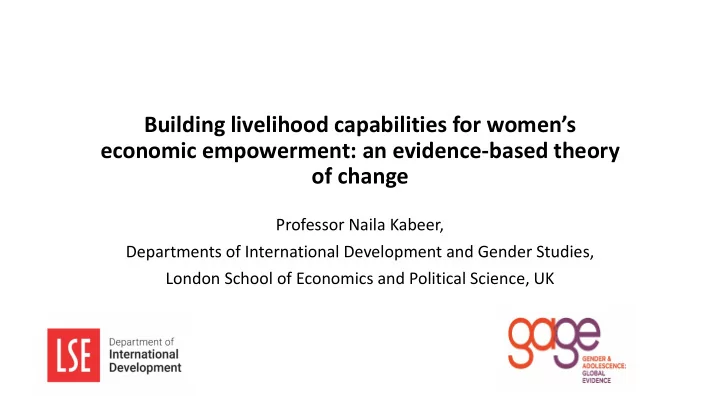

Building livelihood capabilities for women’s economic empowerment: an evidence-based theory of change Professor Naila Kabeer, Departments of International Development and Gender Studies, London School of Economics and Political Science, UK
Structure of presentation Women’s economic empowerment: theorizing processes of change Roadblocks to change: why do interventions fail to translate into resources Roadblocks to change: why do resources fail to translate into capabilities Pathways to change: what helps to translates resources into capabilities Pathways to change: what helps to build an enabling environment Concluding comments: conceptual, methodological and policy concerns Reference: Naila Kabeer (2018) ‘Gender, livelihood capabilities and women’s economic empowerment: reviewing evidence over the life course’ GAGE Working Paper, Overseas Development Institute, UK ( https://www.gage.odi.org/publications/gender-livelihood-capabilities )
The im importance of of stu tudyin ing liv livelih lihood in interventions Growing body of evidence that access to secure and productive livelihoods not only improves women’s practical capacity to look after themselves and their families, but can also provide a strategic pathway for change in other spheres of their lives. It is these latter changes which I would describe as the economic dimensions of empowerment in other words. The interventions in question seek to promote access to a range of different resources considered relevant to women’s livelihood efforts: these may be human (labour, time, knowledge, ‘soft’ and ‘hard’ skills and information, building confidence), material (financial services, productive assets of various kinds) or social (access to those in power, connections with others).
Economic pathways to empowerment I define women’s empowerment as the processes by which those who were denied the ability to exercise choice, voice and influe nce – both within their personal lives and in the wider community – have been able to gain this ability. Embedded in this conceptualization of empowerment is a very rudimentary three- dimensional theory of change, which links women’s access to resources to their capabilities, in other words, to the agency they acquire over different aspects of their lives. Agency here refers to the cognitive capacity for reflection, analysis and goal-setting, the practical capacity to act to achieve these goals as well as a subjective capability, which reflects how women view themselves and their place in society, their ‘sense o f a gency’, self-worth and personhood, their capacity to build dreams. A policy concern with the economic dimensions of empowerment draws attention to impact of various livelihood interventions on their capacity to exercise agency and to achieve valued outcomes in their lives and livelihoods. A theory of change relating to women’s economic empowerment needs to distinguish between practical and strategic capabilities
Why understanding the processes of economic empowerment is important: steady progress on human capabilities have failed to translate into commensurate progress in the economic domain (and even slower progress in the political). Source: World Economic Forum@ Global Gender Gap Report 2016
A three-dimensional theory of change
In Integratin ing th the str tructures of f constrain int in into a th theory ry of f change for r women’s economic empowerment • ‘Intrinsically gendered’ institutions of family, kinship and community • Institutions as ‘bearers of gender’: formal rules, unruly practices, unconscious bias • Feed-back mechanisms • The intersection of gender and other structural inequalities across the life course, from childhood to old age. • And it needs to incorporate life course perspectives, intersecting inequalities and the geography of gender to capture how change might vary for different groups in different contexts • This leads to a more complicated theory of change:
Complicating the theory of change: the ‘structures of constraint’, li liveli lihood in interventio ions and capabil ilit itie ies
Roadblocks to change: exclusions, biases and the persistence of constraints Why do interventions fail to translate into resources: - exclusions, biases, irrelevance Why do resources fail to translate into capabilities: - ‘initial conditions’ - the gender division of unpaid family labour - Intra-household power dynamics - Holes and gaps in opportunity structures
Pathways to change: addressing constraints, building an enabling environment What helps the translation of resources into capabilities? - designing human capital and capabilities interventions to reflect gendered needs, demands, capacities and constraints - Savings-led, group-based approaches to financial services for the poor - Improving access to land - Gender-aware public works programmes - Affordable child care - Multi-stakeholder approaches to labour codes - Multi-component approaches to address multiple and intersecting constraints
Policy pathways to change: addressing constraints, building an enabling environment What helps build an enabling environment? - Allowing for institutional learning - Structural responses to women’s time and mobility constraints - The importance of social solidarity: autonomous women’s organizations and alliance building - State interventions (law and policy) - Transforming the structure of opportunities: employment-centred macroeconomic policies
Concluding reflections • What are we measuring when we measure impact? • How and why does change happen when we find evidence that it happens? • What is missing from the economic empowerment agenda?
Recommend
More recommend